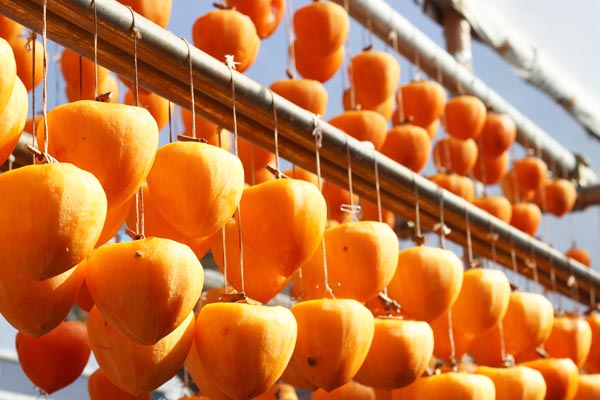
If there’s one season exclusive to foodies, it would be autumn. Considered by Japanese as the appetite-stimulating season, the cooler weather somehow inspires people to once again liven up their dining tables. The oppressive heat and humidity of Japanese summer days suppresses the appetite and people usually don’t want anything to do with the stove and add heat to an already stuffy kitchen. But with the arrival of the cool crisp air of fall, they recover their interest in food once again. Here below are 5 quintessentially Japanese autumn foods you must try as you appreciate the brilliant red and yellow foliage.
1. The One Pot Comfort Food Called Oden

You know it’s definitely autumn when convenience stores fly their “Oden Sale” banners. As you step inside the store, you will see large steaming warmers on the service counter with an assortment of oden pieces you can choose from, simmering in a hot dashi (seaweed and fish based) broth. These are enjoyed with Japanese mustard. Oden probably tops the list of cold weather comfort food. While oden is now readily available in convenience stores, traditional eateries and modern bars, families still make their own pot, slow cooking their favorite oden pieces in their homemade broth, and gathering around the hot pot to warm up. The smell of the broth might take some getting used to.
Surimi fishcakes are traditionally the main ingredient and they come in different shapes and varieties (i.e. fried, with burdock, white and fluffy, long and hollow, etc.). You will find other pieces such as hard boiled eggs, meatballs, big round pieces of daikon (which, after simmering so long, melt in your mouth), knots of kombu or seaweed, konyaku triangles, shirataki noodles tied up in a bunch, tofu triangles, stuffed cabbage rolls, and kinchaku which is gooey mochi and bits of savory meat and mushroom inside a pouch made of tofu skin. There’s something for everyone!
2. Kuri: The Nutty Goodness of Chestnuts

Looking for limited edition flavors of your favorite sweets? You will be delighted to know that your favorite brands like KitKat, Glico’s Pocky, Meiji chocolate, and Haagen Daaz feature marron flavored sweets this season. Marron is French for chestnuts and marron is usually used when referring to Western style chestnut based sweets.
For Japanese style sweet and savory dishes, the word kuri is used. Japanese chestnuts are small to medium sized. One of the simplest ways to enjoy them is cooking the chestnuts together with rice. Flavored with soy sauce, sake, mirin, and kombu kelp, kurigohan celebrate the two things that are harvested in the fall. Then there are the various wagashi (traditional Japanese sweets) made with kuri such as kuri dango (sticky rice balls topped with chestnut paste), kuri yokan (blocks of sweet red bean paste with chunks of steamed chestnuts inside), kuri manju (pastry cake with sweet bean paste and either a whole steamed chestnut or chestnut paste in the middle), kuri mushipan (steamed cake dotted with candied chestnut pieces). Go crazy! Or since we’re talking about chestnuts, go nuts!
3. Kaki: Bright Orange Persimmons

4. Yakiimo: Stone-Baked Sweet Potato

If you’re really lucky, you might hear the song of the yakiimo man, pushing a wooden cart along the smaller streets. In his song, he says, Stone-baked sweet potatoes… Freshly baked and piping hot… Come quick or you’ll miss me. At the bottom of cart are pebbles heated by a wood burning stove on which sweet potatoes are roasted. The distinctive sweet smell wafts out and trails behind the cart, along with the echoes of the yakiimo vendor’s soulful song. I say ‘lucky’ because nowadays, you are more likely to see a small open-backed van driving slowly.
The song might just be a recording rather than sung live. A traditional red lantern hangs from the back for a nostalgic touch. Nonetheless, to many Japanese especially the older generation, live or recorded, this is the musical backdrop of the fall and winter. You will need to try one to understand their timeless appeal — a just-baked sweet potato is naturally sweet and velvety. You can enjoy it by itself, without adding butter (although yakiimo is also delicious with melted butter and a dash of soy sauce). If you have a difficult time looking for a yakiimo vendor, check out the nearest supermarket. They might have a portable cart with roasted sweet potatoes warming on pebbles.
5. Grilled Sanma: The Official fish of the Season

The kanji for Sanma (秋刀魚) literally mean “autumn sword fish,” due to its abundance in the fall and its distinct shape. It’s got a bold flavor similar to herring or sardines. The traditional favorite way of preparing Pacific saury is by grilling it with salt (shioyaki in Japanese) and served with a side of grated daikon or raddish and a slice of lemon. As you can see from the photo, the entire fish is grilled with head, guts and all. The meat near the gut part is bitter but nutritious. Sanma is rich in omega-3 fatty acids EPA and DHA. In the fall, sanma would probably be the star of a traditional Japanese breakfast. Not a fan of seeing fish head and guts? Try sanma fillets pan fried to a crisp or tossed in terriyaki sauce.
Have a scrumptiously delicious autumn!

All of it sounds so good specially the sweet potato and and fish. I love salmon your posts like this are deadly to me and my cravings of Japanese food XD
LikeLiked by 1 person
It’s deadly even to me. I just had salmon while I was writing this post XD.
LikeLiked by 1 person
Haha I love oden!!
LikeLike
[…] who knows me well, knows why the next article catches my eye… 5 Quintessentially Japanese Autumn Foods You Must Try. Food and cooking is another of my central interests, and if you’re exploring the season in […]
LikeLiked by 1 person